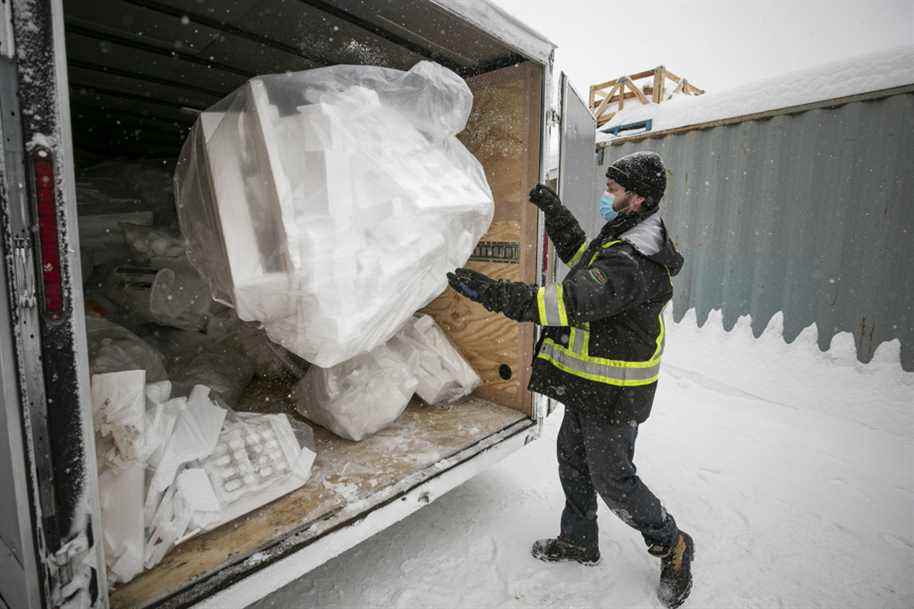Posted at 8:00 a.m.
(Rivière-Rouge) André Séguin throws the big bags filled with pieces of “styrofoam” into the large closed trailer hitched to his pick-up truck.
Every Wednesday, he collects the polystyrene from a dozen institutions, businesses and industries (ICI) in Rivière-Rouge, Nominingue and La Macaza, as well as from four voluntary depots open to citizens.
As in many municipalities in Quebec, polystyrene is not accepted in the selective collection in the region, but the Red Intermunicipal Waste Board (RIDR) has set up a separate collection for this easily recyclable material.
Here, behind the Rona renovation center in Rivière-Rouge, it is mainly household appliance packaging that accumulates in a shed between each collection.
“It’s unpacked at the customer’s, but we bring it back here, it generates a lot of waste,” explains the president and owner of the business, Éric Deslongchamps.

PHOTO DAVID BOILY, THE PRESS
Éric Deslongchamps, president and owner of the Rona renovation center in Rivière-Rouge
Collecting polystyrene, combined with recycling cardboard and building materials, has lowered his business’s waste disposal cost from $30,000 a year to less than $10,000 today, he says. .
Avoid landfill
It is also to avoid the overflow of its landfill that the RIDR has set up this weekly collection of polystyrene, as well as plastic wrap, as part of a pilot project, in 2021.

PHOTO DAVID BOILY, THE PRESS
Marc Forget, Director General of the Rouge Intermunicipal Waste Board
“It’s not just for environmental awareness, it’s that there is a limit to what you can bury,” explains its general manager, Marc Forget.
The RIDR technical landfill, opened in 2006, has reached almost 50% of its capacity – it is divided into eight cells: four are already complete, the fifth is currently in use and the sixth is ready, while the last two will cost 1 million each to develop.

PHOTO DAVID BOILY, THE PRESS
The technical landfill site of the Rouge intermunicipal waste board, in Rivière-Rouge
But the RIDR would prefer not to have to use them and is increasing the recovery and recovery projects for residual materials in the 25 municipalities it serves.
Starting with polystyrene, so light that a single ton of this material is equivalent to the volume of 34 tons of waste, explains Patrice Lanctôt, supervisor at the RIDR.
Transformed into insulation
Very light, generating static electricity, requiring careful sorting, polystyrene is excluded from most recycling bins in Quebec.
Only 18% of municipalities accept it in their selective collection program, and about a hundred ecocentres in the province recover it, according to data from the Quebec Society for Recovery and Recycling (Recyc-Québec).
A collection dedicated to this product was therefore the solution for the RIDR.

PHOTO DAVID BOILY, THE PRESS
Patrice Lanctôt, Supervisor at the Rouge Intermunicipal Waste Board
There’s no reason it can’t be done elsewhere.
Patrice Lanctôt, from the Rouge Intermunicipal Waste Board
The polystyrene recovered by the RIDR is sent to a packer in Saint-Jérôme, which processes it for Inject-Styrène Technologie, a company specializing in the injection of expanded polystyrene insulation.
Depending on whether it is packaging for household appliances, food trays or other types of polystyrene, it can also be used in the manufacture of street furniture, to lighten the components.
“It has to be well supervised, to avoid contamination,” explains Patrice Lanctôt. But the main challenge remains transport, the cost of which can sometimes be “higher than the cost of treatment”.
A profitable approach
Despite all the challenges, the RIDR estimates that it costs it $72 per ton to recover the polystyrene, well below the $100 per ton it costs to landfill waste materials.
Anything that can reduce the quantity of materials sent to landfill is studied with interest by the organization, which relies in particular on incentive pricing.

PHOTO DAVID BOILY, THE PRESS
Rose-Marie Schneeberger, Development Advisor at the Rouge Intermunicipal Waste Board
“Our motto is: ‘let’s make everything that concerns waste more expensive and more complicated and do the opposite for everything else’”, illustrates its development advisor, Rose-Marie Schneeberger.
Thus, institutions, businesses and industries (ICI) are served by municipal collection services and pay a significant amount for their waste bins. Recyclable and organic material recycling bins, on the other hand, are free.
Citizens are not left out: 3 of the 25 municipalities served by the RIDR have moved to the monthly collection of waste from households.

PHOTO DAVID BOILY, THE PRESS
Citizens can return their polystyrene to voluntary drop-off centres, like this one, in one of Rivière-Rouge’s ecocentres.
“That helps convince citizens to participate in the recovery,” says Rose-Marie Schneeberger, who points out that the three municipalities in question are also those that have shown the greatest reduction in waste.
“We must never lose sight of the fact that what we put in the black bin is not waste,” says Patrice Lanctôt. These are raw materials that we do not manage. »
10,000 mattresses per year
Mattresses are another scourge for the Rouge Intermunicipal Waste Board (RIDR), which recovers some 10,000 a year. “People in Montreal bring their old mattress to their cottage [dans les Hautes-Laurentides], when they buy a new one. And when the old mattress is too old, they throw it here,” explains RIDR development advisor Rose-Marie Schneeberger. However, 1 tonne of mattress occupies the volume of 14 tonnes of waste, she explains. The RIDR has therefore set up a program to recover old mattresses, which costs it $42 a ton, much less than the $100 a ton that landfilling costs. The mattresses are shipped to a Montreal company, which says it recycles 88% of their contents.
Figure
25,000m3 : quantity of waste buried annually at the Rivière-Rouge technical landfill
Source: Rouge Intermunicipal Waste Board

